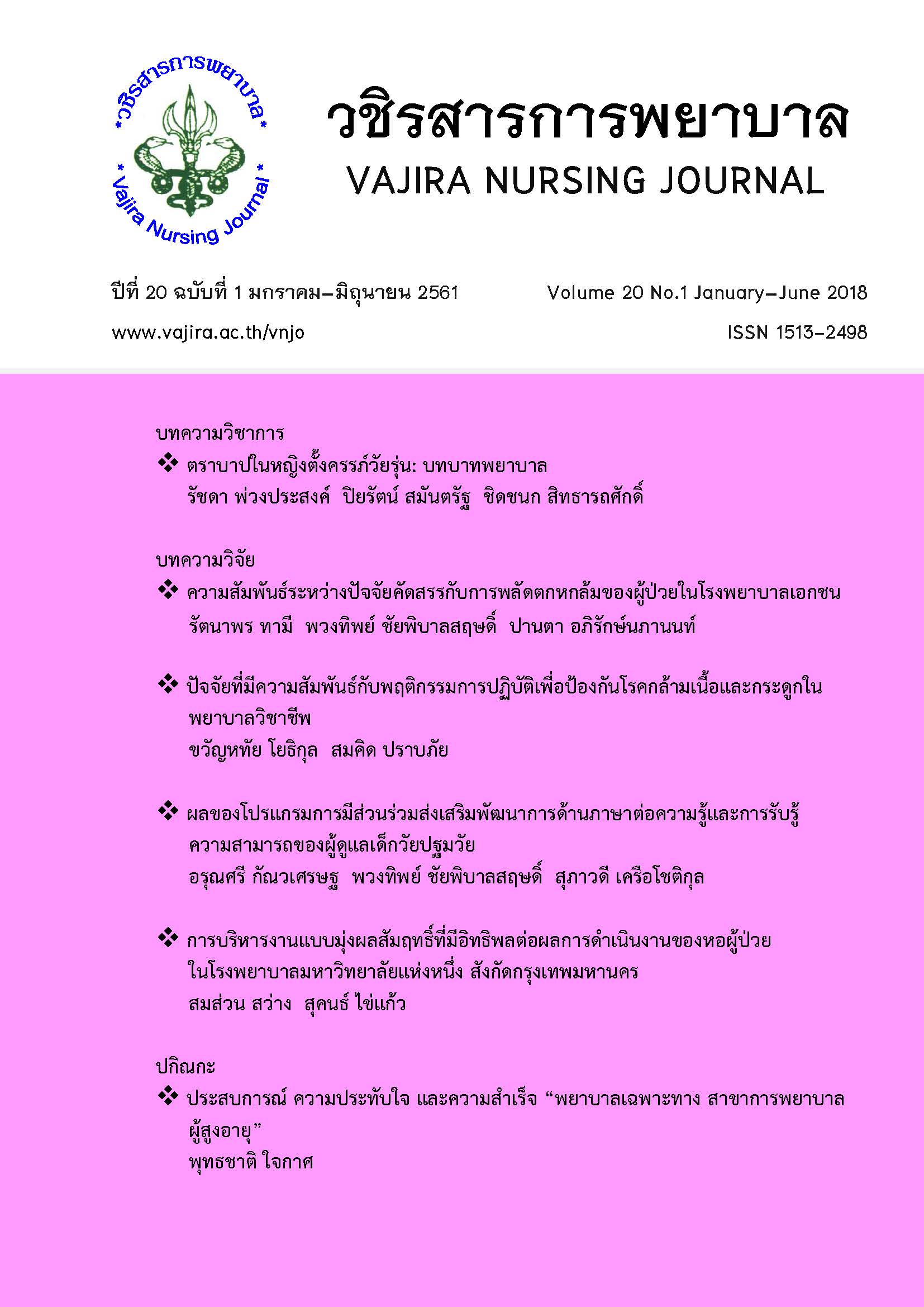ตราบาปในหญิงตั้งครรภ์วัยรุ่น: บทบาทพยาบาล
Main Article Content
บทคัดย่อ
การตั้งครรภ์ในวัยรุ่นเป็นปัญหาสำคัญในระบบสุขภาพของประเทศ เพราะวัยรุ่นส่วนใหญ่อยู่ในช่วงเวลาการศึกษาและการดูแลของครอบครัว การตั้งครรภ์ส่วนใหญ่จึงไม่ได้มีการวางแผนล่วงหน้าหรือมีความไม่พร้อมของหญิงตั้งครรภ์วัยรุ่น จากสภาวะกดดันภายใต้บรรทัดฐานของสังคมที่มองว่าการตั้งครรภ์ควรเกิดขึ้นในวัยที่เหมาะสมและการสมรสอย่างถูกต้องตามประเพณี ส่งผลให้ภาวะทางอารมณ์ของมารดาวัยรุ่นไม่มั่นคง เกิดความรู้สึกสับสนระหว่างการยอมรับและไม่ยอมรับการตั้งครรภ์ จนก่อเกิดเป็นตราบาปต่อหญิงตั้งครรภ์วัยรุ่น ส่งผลกระทบต่อหญิงตั้งครรภ์วัยรุ่น ทารกในครรภ์และครอบครัว พยาบาลมีบทบาทสำคัญในการสนับสนุนและช่วยเหลือให้หญิงตั้งครรภ์วัยรุ่นสามารถลดความรู้สึกตราบาป และสามารถปรับเปลี่ยนบทบาทของตนเองในการเป็นมารดา โดยประสานเชื่อมโยงกับสามี สมาชิกในครอบครัวหรือบุคคลที่หญิงตั้งครรภ์วัยรุ่นเหล่านั้นพึ่งได้ เพื่อร่วมกันวางแผนการดูแลหญิงตั้งครรภ์วัยรุ่นให้สามารถดำเนินชีวิตได้อย่างมีความสุข
Article Details
เนื้อหาและข้อมูลในบทความที่ลงตีพิมพ์ในวชิรสารการพยาบาลถือเป็นข้อคิดเห็นและความรับผิดชอบของผู้เขียนบทความโดยตรง ซึ่งกองบรรณาธิการไม่จำเป็นต้องเห็นด้วย หรือร่วมรับผิดชอบใด ๆ ทั้งสิ้น
บทความ ข้อมูล เนื้อหา รูปภาพ ฯลฯ ที่ได้รับการตีพิมพ์ในวชิรสารการพยาบาล ถือเป็นลิขสิทธิ์ของวชิรสารการพยาบาล หากบุคคลใดหรือหน่วยงานใดต้องการนำทั้งหมดหรือส่วนหนึ่งส่วนใดไปเผยแพร่ต่อหรือเพื่อกระทำการใด ๆ จะต้องได้รับอนุญาตเป็นลายลักอักษรจากวชิรสารการพยาบาลก่อนเท่านั้น
เอกสารอ้างอิง
คณะทำงานวิชาการพัฒนาเครื่องมือการสำรวจสถานการณ์การตีตราและการเลือกปฏิบัติ. (2559). การตีตราและเลือกปฏิบัติในประเทศไทย. สืบค้นจาก
http://www.bangkok.go.th/upload/user/00000150/plan/300958/Overview%20S&D%20Thailand_BMA%2030-9-2015.pdf.
ชาญชัย ศักดิ์ศิริสัมพันธ์, ผ่องพรรณ เกิดพิทักษ์, และประสาร มาลากุล ณ อยุธยา. (2558). การเสริมสร้างความหมายในชีวิตของวัยรุ่นที่ตั้งครรภ์ โดยใช้รูปแบบการให้การปรึกษากลุ่มภวนิยม. วารสารวิจัยทางการศึกษา. 10(1), 34-46.
รัก ชุณหกาญจน์. (2556). การศึกษาการให้อภัยในวัยรุ่น: กรณีศึกษาการให้ความช่วยเหลือด้วยการให้คำปรึกษา เพื่อพัฒนาการให้อภัยสำหรับวัยรุ่นและวัยรุ่นหญิงที่ตั้งครรภ์ไม่พร้อม. (การศึกษาดุษฎีบัณฑิต, มหาวิทยาลัยศรีนครินทรวิโรฒ)
ฤดี ปุงบางกะดี่, และเยาวลักษณ์ เสรีเสถียร. (2551). พยาบาลกับการช่วยเหลือและการดูแลสตรีกับการช่วยเหลือและการดูแลสตรีตั้งครรภ์ไม่พึงประสงค์. วารสารพยาบาลศาสตร์. 26(2-3), 5-16.
วาสนา ถิ่นขนอน, และวิลาวัณย์ ชมนิรัตน์. (2555). การพัฒนาแนวทางการให้บริการหญิงตั้งครรภ์วัยรุ่นโดยครอบครัวมีส่วนร่วมในคลินิกฝากครรภ์เครือข่ายบริการสุขภาพ อำเภอชัยบุรี จังหวัดสุราษฎร์ธานี. วารสารพยาบาลศาสตร์และสุขภาพ, 35(2), 25-33.
วิทิตา สุขทั่วญาติ. (2551). บทเรียนจากการ สะท้อนคิดของนักเรียนหญิงที่ออกกลาง คันเนื่องจากการตั้งครรภ์ไม่พึงประสงค์. (ศึกษาศาสตรมหาบัณฑิต สาขาวิชาจิตวิทยาการศึกษาและการแนะแนว, มหาวิทยาลัยเชียงใหม่).
ศศินันท์ พันธ์สุวรรณ, พัชรินทร์ สังวาลย์, อิชยา มอญแสง, และพัชรินทร์ ไชยบาล. (2556). ประสบการณ์หลังตั้งครรภ์วัยรุ่นที่ไม่ได้แต่งงานใน ภาคเหนือตอนบน. วารสารพยาบาลสงขลานครินทร์. 33(3), 17-36.
ศรุตยา รองเลื่อน, ภัทรวลัย ตลึงจิตร, และสมประสงค์ ศิริบริรักษ์. (2555). การตั้งครรภ์ไม่พึงประสงค์ในวัยรุ่น: การสำรวจปัญหาและความต้องการการสนับสนุนในการรักษาพยาบาล. วารสารพยาบาลศิริราช, 5(1), 14-28.
ศิริพร จิรวัฒน์กุล, สมพร รุ่งเรืองกลกิจ, และนิลุบล รุจิรประเสริฐ. (2559). บทเรียนจากการพัฒนาบริการสายด่วนช่วยเหลือวัยรุ่นตั้งครรภ์. วารสารสภาการพยาบาล, 31(3), 5-15.
สำนักอนามัยและการเจริญพันธ์. (2560). การเฝ้าระวังอัตราการคลอดมีชีพในหญิงอายุ 15-19 ปี. สืบค้นจาก
https://hdcservice.moph.go.th/hdc/reports/report.php?source=pformated/format1.php&cat_id=1ed90bc32310b503b7ca9b32af425ae5&id=1336d766d29c4a739ed33ff9f4e79d83
สุภาวดี เครือโชติกุล, และสกาวเดือน ไพบูลย์. (2557). คุณภาพหญิงวัยรุ่นตั้งครรภ์ไม่พึงประสงค์: บทบาทพยาบาลผดุงครรภ์.วารสารเกื้อการุณย์. 21(2), 18-27.
อุมาพร ตรังคสมบัติ. (2557). การสร้างชีวิตใหม่. กรุงเทพฯ: ซันต้าการพิมพ์.
American Academy of Pediatrics. (2001). Committee on Adolescence and Committee on Early Childhood and Adoption, and Dependent Care. American Academy of Pediatrics: Care of adolescent parents and their children. Pediatrics, 107(2): 429-434.
Afrose, T., Chattopadhyay, A.B., Habib, N., & Rashid, M. (2015). Adolescent Pregnancy, A Social Stigma. MOJ Anat Physiol 1(5), doi:10.15406/mojap.2015.01.00024
Al-Sahab, B., Heifetz, M., Tamim, H., Bohr, Y., & Connolly, J. (2012). Prevalence and characteristics of teen motherhood in Canada. Matern Child Health J, 16(1), 228-234, doi:10.1007/s10995-011-0750-8
Becker, H.S. (1991). Outsiders. New York: Free Press.
Brubaker, S.J. (2007). Denied, embracing, and resisting medicalization: African American teen mothers’ perceptions of formal pregnancy and childbirth care. Gender & Society, 21, 528-552, doi:10.1177/0891243207304972
Desocio, J.E., Holland, M.L., Kitzman, H.J., & Cole, R.E, (2013). The Influence of Social-Developmental Context and Nurse Visitation Intervention on Self-Agency Change in Unmarried Adolescent Mothers. Research in Nursing & Health, 36, 158-170.
Fessle, K.B., (2003). Social Outcomes of Early Childbearing: Important Considerations for the Provision of Clinical Care. Journal of Midwifery & Women’s Health. 48(3), 178-185.
Fulford, A., & Ford-Gilboe, M. (2004). An exploration of the relationships between health promotion practices, health work, and felt stigma in families headed by adolescent mothers. Canadian Journal of Nursing Research, 36(4), 46-72.
Goffman, E. (2009). Stigma: Notes on the Management of Spoiled Identity. New York: Simon and Schuster.
Goffman, E. (1963). Stigma: Notes on the management of spoiled identity. Englewood Clifs, NJ: Prentice Hall.
Gregson, J. (2009). The culture of teenage mothers. Albany, NY: State University of New York Press.
Happell, B. (2005). Mental Health Nursing: challenging stigma and discrimination towards people experiencing a mental illness. Int J Ment Health Nurs, 14(1), doi:10.1111/j.1440-0979.2005.00339.x
Haynes-Lawrence, D. (2008). Home visitors’ perceptions of teen mothers: Using qualitative research to explore labeling theory. Children and Youth Services Review, 30, 1386-1394, doi:10.1016/j. childyouth. 2008.04.007
Higginbottom, G. M., Mathers, N., Marsh, P., Kirkham, M., Owen, J. M., & Serrant-Green, L. (2006). Young people of minority ethnic origin in England and early parenthood: Views from young parents and service providers. Social Science & Medicine, 63(4), 858-870, doi:10.1016/j.socscimed.2006.03.011
Hofferth S.L. & Reid, L. (2002) Early Childbearing and Children’s Achievement and Behavior over Time. Perspect Sex Reprod Health, 34(1): 41-49.
House, J.S., Umberson, D., & Landis, K.R. (1988). Structures and Processes of social support. Annual Reviews of Sociology, 14, 293-318.
L’Engle, K.L., Brown, J.D., & Kenneavy, K. (2006). The mass media are an important context for adolescents’ sexual behavior. J Adolesc Health, 38(3), 186-192.
Link, B.G., & Phelan, J.C. (2001). Conceptualizing Stigma. Annual Review of Sociology, 27, 363–85, doi:10.1146/annurev.soc.27.1.363
Lowdermilk, D. L., & Perry, S. E. (2004). Maternity & women’s health care (8th ed). St. Louis, MO: Mosby.
Mandal, P. & Prakash, S. (2014). Stigma of Mental Disorders and Role of Nursing Professionals: A Developing Country Perspective. J Nurs Care, 3, doi:10.4172/2167-1168.1000190
Mercer, R.T. (1985). The process of maternal role attainment over the first year. Nurs Res, 34(4), 198-204.
Olsson, P. & Wijewardena, K. (2010). Unmarried woman’s decisions on pregnancy termination: Qualitative interviews in Colombo, Sri Lanka. Sexual & Reproductive Healthcare, 1, 135-141.
Peterson, W. E., Sword, W., Charles, C. & DiCenso, A. (2007). Adolescents’ perceptions of inpatient postpartum nursing care. Qualitative Health Research, 17(2), 201-212, doi:10.1177/1049732306297414
Phuangprasonka, R., Deoisres, W., & Chunleskul, K. (2016). Maternity blues and management strategies of Thai postpartum women. (Doctoral dissertation, Burapha University)
Ponsford, R. (2011). Consumption, resilience, and respectability amongst young mothers in Bristol. Journal of Youth Studies, 14, 541-560, doi:10.1080/13676261.2011.559217.
Schultz, K. (2001). Constructing failure & narrativing success: Rethinking the “problem” of teen pregnancy. Teachers College Record, 103(1), 582-607.
Stapleton, H. (2010). Surviving teenage motherhood: Myths and realities. United Kingdom: Palgrave Macmillan.
Udmuangpia, T., Häggström-Nordin, E., Worawong,C., Tanglakmankhonge, K., & Bloom, T. (2017). A Qualitative study: Perceptions Regarding Adolescent Pregnancy Among A Group of Thai Adolescents in Sweden. Pacific Rim International Jornal of Nursing Res, 21(1) 75-87.
World Health Organization. (2010). Adolescent pregnancy. Retrieved from
http://www.who.int/making_pregnancy_safer/topics/adolescent_pregnancy/en/print. html.
World Health Organization. (2012). Early marriages, adolescent and young pregnancies: Report by the Secretariat. Retrieved from
http://apps.who.int/gb/ebwha/pdf_files/WHA65/A65_13-en.pdf
Yardley, E. (2008). Teenage mothers’ experiences of stigma. Journal of Youth Studies, 11(6), 671-684.


